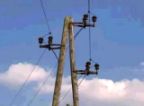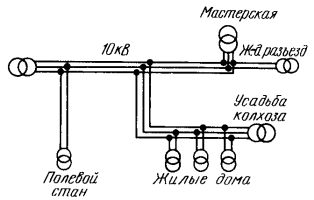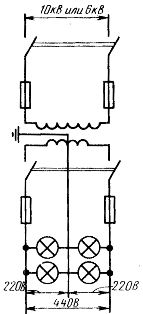Three-phase single-phase networks
 In agriculture, electrical energy is distributed in three-phase networks with a voltage of, as a rule, 10 kV with transformer consumer points. This distribution system was adopted without significant changes from utility practice for supplying electricity to small towns and suburbs with low-rise buildings. However, in rural conditions the density of the electric load is much lower than in cities, and therefore the modern system of electricity distribution leads in many cases to a significant overexpenditure of the metal of the wires.
In agriculture, electrical energy is distributed in three-phase networks with a voltage of, as a rule, 10 kV with transformer consumer points. This distribution system was adopted without significant changes from utility practice for supplying electricity to small towns and suburbs with low-rise buildings. However, in rural conditions the density of the electric load is much lower than in cities, and therefore the modern system of electricity distribution leads in many cases to a significant overexpenditure of the metal of the wires.
Its serious disadvantage is the heavy networks with a voltage of 380 V. Due to the relatively large capacity of the transformer stations (on average 63 — 100 kVA), each transformer serves a significant area, which requires the use of wires with a large cross-section in networks with a voltage of 380 V. As a result on top of that, wire metal is usually consumed in 2 — 3 times more than in 10 kV networks.
Wire consumption in low-voltage networks can be reduced by increasing the number of transformer stations and reducing their average power and service radius. However, the three-phase transformer station is a relatively expensive construction, the cost of which decreases slightly with a decrease in the power of the installed transformer. Therefore, reducing the average power of a transformer station below 40 or 63 kVA in three-phase networks leads to an excessive increase in the total cost of transformer stations. Therefore, this way of reducing the consumption of wires in low-voltage networks is not always economical.
On the other hand, in three-phase power distribution, it is often necessary to supply three 10 kV network conductors to small consumers. In this case, the cross-sections of the wires are taken above the necessary, depending on the conditions voltage loss, as they are chosen as the minimum permissible in terms of mechanical strength. As a result, excess metal is consumed in the high voltage network.
To overcome the shortcomings of the existing power distribution system, a mixed three-phase single-phase distribution system.
The essence of the mixed power distribution system is as follows.
1. Mixed three-phase single-phase lines with a voltage of 10 kV are used, where the main lines are three-phase and all large, including power, consumers are connected to them. Small consumers, mainly lighting and household loads, are supplied by single-phase 10 kV branch lines.
2. Low-power single-phase transformer stations are used to supply single-phase consumers.
An approximate diagram of a network with transformer stations made according to a mixed three-phase single-phase system is shown in Figure 1.

Rice. 1. Example of a diagram of a mixed three-phase single-phase network
As can be seen from this chart, large users with mostly power load have a three-phase power supply, and small consumers, mostly residential buildings, are powered by single-phase transformer stations. Single-phase transformers includes voltage between phases.
Comparative calculations show that the use of a mixed system can reduce the consumption of metal in high and low voltage wires by 25 - 35% compared to a conventional three-phase system. The initial cost of the network at existing prices and types of equipment can be reduced by using a mixed system to only 5-10%.
In a high-voltage network made in a mixed system, single-phase transformers are delta-connected for a network voltage of 6 or 10 kV, as shown in Figure 1.
It has been proven that in an unevenly loaded three-phase network, the sum of the linear voltage losses at these loads remains unchanged regardless of the distribution of the loads between the phases, i.e. dUab + dUbc + dUca = const.
In practice, there are always a significant number of single-phase loads connected to the network. These loads can be distributed so that the phase-to-phase voltage losses to the endpoints are approximately equal to each other: dUab ≈ dUbc ≈ dUca
In this case, the performance of a non-uniformly loaded line is the same as that of a three-phase uniformly loaded line with the same parameters. In all other cases, performance is lower.
Obviously, when designing a network for a mixed system, it is necessary, by distributing the loads accordingly, to achieve the condition of equality between the phase-to-phase voltage losses. In this case, the voltage losses in a three-phase line are determined by the formulas for a symmetrical load and they have the lowest possible value. The calculation in this case is greatly simplified.
Single-phase branches from a 10 kV network have 2-6 times less bandwidth than three-phase branches with the same cross-section. However, with low-power transformer stations, very often the cross-section of branch wires is determined by the minimum permissible for mechanical reasons. In this case, they are single-phase, the branches have two wires of the same cross-section instead of three, and the economy of metal wire is 33%.
A single-phase low-voltage network according to a mixed system is made three-wire with an average conductor. The voltage between the middle and end wires is 220 V (Fig. 2), and between the end wires is 440 V. The middle wire is grounded in the same way as the neutral wire in a 380 V system with a grounded neutral, and metal parts of the equipment are also connected to it . The lighting is switched on between the middle and outer wires, and the power between the outer wires. Small 2 kVA transformers have two low voltage outputs — 220 or 127 V.
Single-phase transformer stations are implemented according to the schematic diagram shown in Figure 2.
 Rice. 2. Scheme of a single-phase transformer station
Rice. 2. Scheme of a single-phase transformer station
The transformers are suspended on a simple 10 kV intermediate network support.They are connected to a high-voltage network through a disconnector installed on an adjacent support. Transformers are protected against short circuits with high voltage fuses.
On the low voltage side, a circuit breaker and fuses are mounted in a small box.
Lines with a voltage of up to 1 kV with a mixed system are performed as in conventional networks. If the routes coincide, it is recommended to hang them on the same supports with high voltage lines.
In the majority of mixed system cases, three-phase induction motors fed from three-phase lines are usually used. Low power single-phase electric motors are used in places where only single-phase power is available, for example, a fan motor on a portable hearth in a field mill, a pump motor on a railway junction, etc. Typically, the power of such motors is 1 — 2 kW and rarely 3 — 4 kW.
It is best to use special asynchronous electric motors with starting capacitors in single-phase networks. In the absence of special motors, you can use standard three-phase electric motors with a voltage of 380/220 V with starting devices in the form of capacitors or even active resistances.
The starting torque of a motor with an active starting resistance at a voltage of 440 V is about 0.4 of the rated torque of the motor in three-phase mode, which corresponds to 0.65-1.0 of the rated torque in single-phase mode.
If for a working machine the starting torque should be more than 0.5 Mn, a motor with a larger power is selected or it is connected according to a capacity circuit.When the starting capacity is turned on, the motor torque is approximately equal to the rated torque in three-phase mode.
When fed from a 10 kVA transformer, motors with a rated power in three-phase mode up to 4.5 kW can be started.
Single-phase motors, both of special construction and converted from three-phase motors, are 1.5-2 times more expensive than three-phase motors of the same power. However, the increase in the cost of motors is insignificant compared to the savings that are obtained in building and operating the network using a mixed power distribution system.
The ratio between single-phase and three-phase power in a high-voltage network depends on the nature of the load and the conditions of its placement.
For most rural areas, single-phase high-voltage lines with a voltage of 10 kV prevail mainly in two cases:
1) on the outskirts of large villages with a predominant load of residential buildings,
2) as branches for the separation of small settlements where the development of electricity is not foreseen in the near future.
The use of single-phase power should be considered economically feasible when significant savings in metal wire are achieved without increasing network costs. This condition, as a rule, is feasible in cases where the use of a single-phase circuit does not lead to a significant increase in the length of the high-voltage network.
I. A. Budzko
